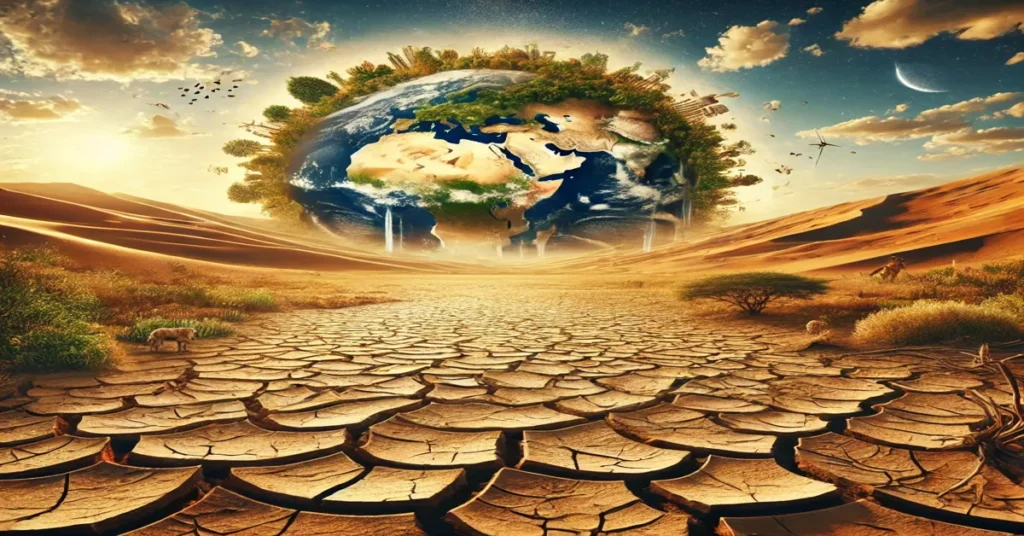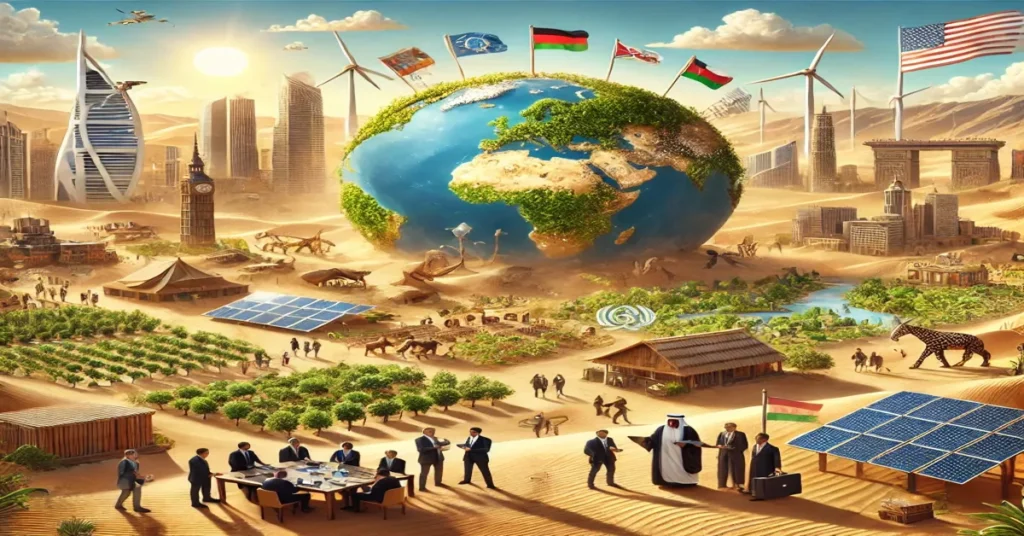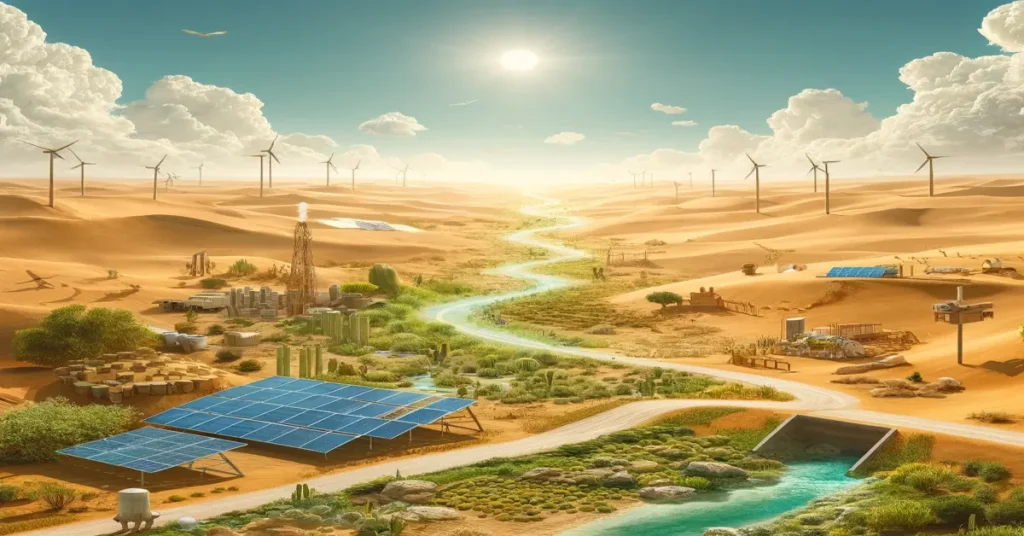Introduction
Deserts, often viewed as barren and lifeless, are home to diverse ecosystems that play a critical role in the balance of our planet’s environment. However, as climate change accelerates and human activities continue to strain natural resources, deserts around the world are becoming increasingly vulnerable to degradation. The “Desert Threat Years” refers to this crucial period in which the world’s deserts are under unprecedented environmental threat due to factors like desertification, biodiversity loss, and the impacts of climate change.
This article will explore the challenges that deserts face during the Desert Threat Years, focusing on how human-induced pressures, climate change, and unsustainable land use are contributing to the transformation of desert ecosystems. It will also discuss the ecological, economic, and social impacts of desert threats and the solutions that could help mitigate the damage and promote desert conservation.
1. What are the Desert Threat Years?
The term “Desert Threat Years” refers to a critical period in the early 21st century when desert ecosystems worldwide face heightened threats due to rapid environmental changes. These threats primarily stem from climate change, unsustainable land use, and human exploitation of natural resources, all of which exacerbate desertification, biodiversity loss, and resource scarcity.

1.1. Definition and Scope of the Desert Threat
Deserts cover about one-third of the Earth’s land surface and include ecosystems as varied as the Sahara in Africa, the Arabian Desert in the Middle East, and the Sonoran Desert in North America. Although these environments are naturally dry and harsh, they are increasingly threatened by human activity and climate change.
- Climate Change: Rising global temperatures and changing precipitation patterns are transforming desert ecosystems, making them hotter and even drier. These changes disrupt the delicate balance that sustains desert biodiversity and human communities.
- Human Activity: Overgrazing, deforestation, unsustainable farming practices, and water mismanagement have accelerated desertification, turning once productive land into uninhabitable deserts. As human populations grow, desert regions are being pushed to their ecological limits.
1.2. Timeline of the Desert Threat Years
The Desert Threat Years began in the late 20th century but have become more pronounced in the 21st century due to the rapid acceleration of global warming and environmental degradation. These years represent a window of time in which urgent action is needed to mitigate the growing threats to desert ecosystems.
- 20th Century Onset: Desertification was first recognized as a significant global issue in the 1970s, when droughts in the Sahel region of Africa triggered widespread famine and land degradation. This period marked the beginning of the recognition of human-induced threats to desert ecosystems.
- 21st Century Crisis: The ongoing rise in global temperatures and intensification of extreme weather events have made the early 21st century a critical period for addressing desert threats. Scientists predict that without immediate action, many desert regions could face irreversible damage in the coming decades.
2. Environmental Threats Facing Deserts
Deserts are facing a complex array of environmental threats during the Desert Threat Years. These threats include desertification, biodiversity loss, water scarcity, and the impacts of climate change, all of which contribute to the degradation of desert ecosystems and the livelihoods of people who depend on them.

2.1. Desertification
Desertification is the process by which fertile land becomes desert as a result of drought, deforestation, or inappropriate agricultural practices. It is one of the most significant threats facing deserts today, affecting over 250 million people worldwide and degrading more than 3.6 billion hectares of land.
- Causes of Desertification: Overgrazing, deforestation, and unsustainable farming practices are major drivers of the Desert Threat Years. In arid and semi-arid regions, the removal of vegetation and the overuse of water resources strip the land of its ability to retain moisture, leading to soil erosion and degradation.
- Impact on Ecosystems: Desertification leads to the loss of vegetation and biodiversity, as plants and animals that are adapted to desert environments are unable to survive in increasingly degraded landscapes. This results in reduced ecosystem services, such as soil stabilization, water filtration, and carbon sequestration.
2.2. Biodiversity Loss
Deserts are home to a wide range of unique plant and animal species that have adapted to survive in extreme conditions. However, the pressures of climate change, habitat destruction, and overexploitation of resources are driving many desert species toward extinction.
- Vulnerable Species: Desert species such as the Arabian oryx, the fennec fox, and the saguaro cactus are at risk due to habitat loss and environmental changes. These species have evolved to thrive in specific desert climates, but as those climates become more extreme or change entirely, their survival is threatened.
- Loss of Habitat: Human activities such as urban expansion, mining, and agriculture encroach on desert habitats, leading to fragmentation and the displacement of wildlife. As habitats are destroyed, the species that depend on them face increased competition for resources and higher risks of extinction.
2.3. Water Scarcity and Mismanagement
Water scarcity is a defining feature of desert ecosystems, but human activities have exacerbated this issue, making it one of the most critical challenges during the Desert Threat Years. Mismanagement of water resources, including the over-extraction of groundwater and the diversion of rivers for agriculture and urban use, has put immense pressure on desert water supplies.
- Aquifer Depletion: Many desert communities rely on underground aquifers for their water supply. However, excessive extraction of groundwater has led to the depletion of these aquifers, which can take hundreds or even thousands of years to recharge. This has resulted in water shortages that threaten both human populations and desert ecosystems.
- Water Wars: In regions where water is already scarce, competition for resources has led to conflict. Water scarcity in desert regions can exacerbate social and political tensions, leading to disputes between neighboring countries or communities over access to dwindling water supplies.
2.4. Climate Change
Climate change is a major driver of the environmental threats facing deserts. Rising global temperatures and changes in precipitation patterns are exacerbating the harsh conditions of desert regions, making them even more vulnerable to degradation.
- Rising Temperatures: Deserts are already some of the hottest places on Earth, but climate change is driving temperatures even higher. This can lead to more frequent and severe heatwaves, increased evaporation rates, and a reduction in the availability of water resources.
- Shifts in Precipitation: In many desert regions, climate change is causing shifts in precipitation patterns, resulting in longer droughts and more intense storms. These changes disrupt the natural cycles that sustain desert ecosystems and make it more difficult for plants and animals to survive.
3. Social and Economic Impacts of Desert Degradation
The environmental threats facing deserts during the Desert Threat Years are not only ecological but also have profound social and economic consequences. Millions of people around the world live in desert regions, and many rely on the land for agriculture, livestock, and livelihoods. As deserts degrade, the human communities that depend on them face increasing hardship.

3.1. Impact on Agriculture and Livelihoods
Desert regions are often home to traditional farming and herding communities that rely on the land for their livelihoods. However, desertification and water scarcity have made it increasingly difficult for these communities to sustain their agricultural practices.
- Loss of Arable Land: As desertification progresses, once-fertile land becomes barren, making it difficult to grow crops or graze livestock. This has led to a decline in agricultural productivity and food security in desert regions, forcing many people to abandon their land and migrate in search of better opportunities.
- Economic Displacement: The degradation of desert ecosystems has resulted in the displacement of entire communities, particularly in regions where agriculture is the primary source of income. This displacement has economic, social, and cultural consequences, as people are forced to leave their homes and seek new livelihoods in unfamiliar environments.
3.2. Human Migration and Urbanization
The environmental degradation of deserts has contributed to increased human migration and urbanization, as people are forced to leave their homes in search of better living conditions. This migration has significant implications for both the rural areas left behind and the urban centers that receive an influx of migrants.
- Rural Exodus: As desert regions become less hospitable, many people migrate to urban areas in search of employment and resources. This rural exodus leaves behind depopulated communities and abandoned agricultural lands, further accelerating desertification.
- Urban Challenges: The influx of migrants into cities places additional strain on urban infrastructure and resources, particularly in developing countries. Rapid urbanization can lead to overcrowding, increased demand for water and energy, and heightened social tensions.
3.3. Conflict and Political Instability
Desert degradation and resource scarcity have the potential to fuel conflict and political instability, particularly in regions where competition for resources is already high. As water and arable land become more scarce, tensions between neighboring countries, ethnic groups, or social classes can escalate into conflict.
- Resource Wars: In regions like the Middle East and North Africa, where water is already a scarce resource, desertification and climate change are exacerbating tensions over water rights. Competition for access to water can lead to conflicts between countries or between different groups within a country.
- Political Instability: The displacement of communities due to desertification and environmental degradation can contribute to political instability, particularly in regions where governments are unable to provide adequate support or resources for affected populations. This instability can lead to social unrest, protests, and even armed conflict.
4. Global Efforts to Combat Desert Threats
In response to the growing threats facing desert ecosystems, international organizations, governments, and NGOs have launched initiatives to combat desertification, promote sustainable land use, and mitigate the impacts of climate change. These efforts are critical for protecting desert ecosystems and ensuring that desert communities can adapt to the challenges posed by the Desert Threat Years.

4.1. The United Nations Convention to Combat Desertification (UNCCD)
One of the most significant global efforts to address desertification and land degradation is the United Nations Convention to Combat Desertification (UNCCD). Established in 1994, the UNCCD is the only legally binding international agreement that links environment and development to sustainable land management.
- Objectives: The UNCCD aims to combat desertification, mitigate the effects of drought, and promote sustainable land management practices in dryland ecosystems. It works with member countries to develop national action plans to prevent land degradation and restore degraded lands.
- Land Degradation Neutrality: One of the key targets of the UNCCD is achieving “Land Degradation Neutrality” (LDN) by 2030. This means that countries aim to ensure that the amount of land that is being degraded is balanced by efforts to restore and rehabilitate degraded land. The LDN target encourages countries to adopt sustainable land-use practices and invest in restoration projects.
4.2. The Great Green Wall Initiative
The Great Green Wall initiative is an ambitious project led by the African Union to combat desertification in the Sahel region of Africa. The initiative aims to create a massive belt of trees and vegetation stretching across the width of the continent, from Senegal in the west to Djibouti in the east. This “green wall” is intended to halt the spread of the Sahara Desert and restore degraded lands.
- Reforestation and Land Restoration: The Great Green Wall initiative focuses on reforesting degraded areas, restoring ecosystems, and improving agricultural productivity in the Sahel. By planting trees and restoring vegetation, the project helps prevent soil erosion, improve water retention, and create sustainable livelihoods for local communities.
- Climate Resilience: In addition to combating desertification, the Great Green Wall initiative aims to build climate resilience in some of the world’s most vulnerable regions. By restoring ecosystems and improving land management practices, the project helps communities adapt to the impacts of climate change, such as drought and extreme weather events.
4.3. Sustainable Agriculture and Water Management
Sustainable agricultural practices and improved water management are essential for addressing desert threats during the Desert Threat Years. These practices help prevent land degradation, conserve water resources, and improve the resilience of desert ecosystems.
- Agroforestry: Agroforestry, the practice of integrating trees and shrubs into agricultural landscapes, is a powerful tool for combating desertification. Trees help stabilize the soil, reduce water runoff, and create microclimates that support crop growth. Agroforestry also promotes biodiversity and improves the overall health of ecosystems.
- Water Harvesting: In water-scarce desert regions, innovative water harvesting techniques are crucial for sustainable agriculture and ecosystem restoration. Techniques such as rainwater harvesting, the construction of water catchments, and the use of drip irrigation help conserve water and reduce the pressure on already stressed water resources.
4.4. Climate Adaptation and Mitigation Strategies
Climate change is one of the driving forces behind the Desert Threat Years, and addressing its impacts on desert ecosystems requires both adaptation and mitigation strategies. These strategies involve reducing greenhouse gas emissions, building resilience to climate change, and investing in renewable energy sources.
- Renewable Energy in Deserts: Desert regions have enormous potential for renewable energy production, particularly solar energy. Large-scale solar projects in desert areas, such as the Noor Solar Complex in Morocco and the Ivanpah Solar Electric Generating System in the United States, help reduce reliance on fossil fuels and provide clean energy for local and regional use.
- Climate Adaptation for Desert Communities: Desert communities are among the most vulnerable to the impacts of climate change, and adaptation strategies are essential to ensure their survival. These strategies include improving infrastructure to withstand extreme heat, developing drought-resistant crops, and investing in early warning systems for droughts and extreme weather events.
5. The Future of Deserts and the Path Forward
The Desert Threat Years represent a critical period in which decisive action must be taken to protect desert ecosystems and the communities that rely on them. As the global population continues to grow and the impacts of climate change become more pronounced, the pressure on deserts will only increase. However, with concerted efforts at the local, national, and international levels, it is possible to mitigate these threats and promote the sustainable management of desert regions.

5.1. The Role of Policy and Governance
Effective policies and governance are essential for addressing the environmental challenges of the Desert Threat Years. Governments, international organizations, and local communities must work together to implement policies that promote sustainable land use, protect biodiversity, and ensure equitable access to resources.
- Land Use Policies: Governments must adopt land-use policies that prioritize sustainable agriculture, reforestation, and the protection of desert ecosystems. These policies should encourage practices that prevent desertification and promote the restoration of degraded lands.
- International Cooperation: Desert threats are a global challenge that requires international cooperation. Countries must work together through agreements like the UNCCD and the Paris Agreement to address the root causes of desertification and climate change. Collaboration on research, technology transfer, and funding for desert conservation projects will be key to building a sustainable future for desert regions.
5.2. Technological Innovations for Desert Sustainability
Technological innovations hold great potential for addressing the environmental challenges facing deserts. From advancements in renewable energy to new agricultural techniques, technology can play a crucial role in promoting sustainability in desert regions.
- Desert Agriculture Innovations: Innovations in desert agriculture, such as hydroponics and vertical farming, offer new ways to grow crops in arid environments. These techniques reduce the need for large amounts of water and can be implemented in desert communities to improve food security.
- Renewable Energy in Deserts: As mentioned earlier, deserts are ideal locations for large-scale solar energy projects. Advancements in solar technology, such as more efficient photovoltaic panels and energy storage systems, can help deserts become key players in the global shift towards renewable energy.
5.3. Education and Community Engagement
Education and community engagement are essential for building a sustainable future for deserts. By raising awareness of the importance of desert ecosystems and empowering local communities to take action, we can promote environmental stewardship and ensure the long-term survival of desert landscapes.
- Environmental Education Programs: Environmental education programs that focus on desert ecosystems can help raise awareness of the challenges facing these regions. Schools, NGOs, and governments should invest in programs that teach children and adults about the importance of sustainable land use, water conservation, and biodiversity protection in deserts.
- Community-Led Conservation Initiatives: Local communities are often the first to feel the impacts of desert threats, and they are also the best positioned to implement solutions. Community-led conservation initiatives that involve local people in the management of natural resources can help ensure that desert ecosystems are protected for future generations.
Conclusion: Protecting Deserts for Future Generations
The Desert Threat Years represent a pivotal moment in the history of the world’s desert regions. As human populations grow, climate change accelerates, and natural resources become increasingly scarce, deserts face unprecedented environmental challenges. However, through international cooperation, sustainable land management, technological innovation, and community engagement, it is possible to mitigate these threats and promote the conservation of desert ecosystems.
Protecting deserts is not only an environmental imperative but also a social and economic necessity. Millions of people around the world depend on deserts for their livelihoods, and the biodiversity of these regions plays a critical role in the health of the planet. By taking action now, we can ensure that deserts continue to provide vital ecosystem services and remain a source of resilience in the face of global environmental challenges.
In the coming years, it will be essential for policymakers, scientists, and communities to work together to address the challenges of the Desert Threat Years and to build a sustainable future for the world’s deserts. With the right strategies in place, deserts can thrive once again, providing life, resources, and beauty to future generations.
Read More: What Color is the Dirt in Albuquerque? Exploring the Environmental and Geological Significance

